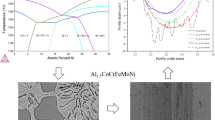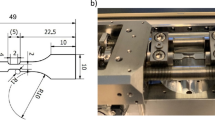Abstract
This paper presents a molecular dynamics analysis of a bimodal nanocrystalline Cu-Ag alloy based on a scaling method. This method generates grain boundary affect zone (GBZA) of a bimodal nanocrystalline Cu-Ag alloy with a bimodal structure by isometric scaling of voronoi boundary vertices. Based on molecular dynamics simulation, the uniaxial tensile tests of bimodal nanocrystalline Cu-Ag alloy have been carried out, and its deformations under different strain conditions are studied while the influences of this deformation on its properties are analyzed. The effect of the coarse grain size of the atoms on the mechanical properties of the alloy has been investigated in previous experimental studies. In this thesis, we will further investigate the effect of the silver atomic composition content of the alloy matrix on its mechanical properties. By observing the internal microstructure of the experimental samples undergoing dislocation movements, it has been found that changing the Ag atomic composition content of the matrix gives feedback on the properties of the material. The specific manifestations of the influence of these variables on the dislocation activity of bimodal nanocrystalline Cu-Ag alloys and the corresponding deformation mechanisms hidden behind them are explored in detail.









Similar content being viewed by others
References
Y. Gong, J. Gu, S. Ni et al., A good combination of strength and ductility of ultra-coarse-grained Cu-Al alloy with coarse-grained surface layer via pre-torsional treatment. Micron 129, 102783 (2020)
Y.-K. Li, M. Zha, H.-L. Jia et al., Tailoring bimodal grain structure of Mg-9Al-1Zn alloy for strength-ductility synergy: co-regulating effect from coarse Al2Y and submicron Mg17Al12 particles. J. Magnes. Alloys 9(5), 1556 (2021)
A. Magee, L. Ladani, T.D. Topping et al., Effects of tensile test parameters on the mechanical properties of a bimodal Al–Mg alloy. Acta Mater. 60(16), 5838 (2012)
W. Zhang, C.A. Simpson, P. Lopez-Crespo et al., The effect of grain size on the fatigue overload behaviour of nickel. Mater. Design 189, 108526 (2020)
J.M. Oh, C.H. Park, J.-T. Yeom et al., High strength and ductility in low-cost Ti–Al–Fe–Mn alloy exhibiting transformation-induced plasticity. Mater. Sci. Eng. A 772, 138813 (2020)
C.X. Ren, Q. Wang, J.P. Hou et al., Exploring the strength and ductility improvement of Cu–Al alloys. Mater. Sci. Eng. A 786, 139441 (2020)
F. Zheng, G. Zhang, X. Chen et al., A new strategy of tailoring strength and ductility of CoCrFeNi based high-entropy alloy. Mater. Sci. Eng. A 774, 138940 (2020)
Y. Ma, S. Zhang, Y. Xu et al., Effects of temperature and grain size on deformation of polycrystalline copper-graphene nanolayered composites. Phys. Chem. Chem. Phys. 22(8), 4741 (2020)
H. Wang, F. Wang, H. Liu et al., Influence of alloy elements (Mo, Nb, Ti) on the strength and damping capacity of Fe-Cr based alloy. Mater. Sci. Eng. A 667, 326 (2016)
T. Zientarski, D. Chocyk, Strain and structure in nano Ag films deposited on Au: Molecular dynamics simulation. Appl. Surf. Sci. 306, 56 (2014)
Y. Li, H. Chen, Y. Chen et al., Point defect effects on tensile strength of α−zirconium studied by molecular dynamics simulations. Nucl. Mater. Energy 20, 100683 (2019)
F. Zhang, G. Li, D. Zhu et al., Grain size effect on the mechanical behaviors in nanocrystalline Cu-Ag alloy with grain boundary affect zone segregation. Mater. Lett. 278, 128406 (2020)
R. Freitas, M. Asta, M. de Koning, Nonequilibrium free-energy calculation of solids using LAMMPS. Comput. Mater. Sci. 112, 333 (2016)
F. Yazdandoost, R. Mirzaeifar, Generalized stacking fault energy and dislocation properties in NiTi shape memory alloys. J. Alloy. Compd. 709, 72 (2017)
P.R. Budarapu, R. Gracie, S.P.A. Bordas et al., An adaptive multiscale method for quasi-static crack growth. Comput. Mech. 53(6), 1129 (2014)
H. Talebi, M. Silani, S.P.P.A. Bordas et al., A computational library for multiscale modeling of material failure. Comput. Mech. 53(5), 1047 (2014)
H. Talebi, M. Silani, T. Rabczuk, Concurrent multiscale modeling of three dimensional crack and dislocation propagation. Adv. Eng. Softw. 80, 82 (2015)
P.L. Williams, Y. Mishin, J.C. Hamilton, An embedded-atom potential for the Cu-Ag system. Model. Simul. Mater. Sci. Eng. 14, 817 (2006)
A.V. Lunev, S.V. Starikov, T.N. Aliev et al., Understanding thermally-activated glide of 1/2〈110〉{110} screw dislocations in UO2—a molecular dynamics analysis. Int. J. Plast. 110, 294 (2018)
T. Zhang, K. Zhou, Z.Q. Chen, Strain rate effect on plastic deformation of nanocrystalline copper investigated by molecular dynamics. Mater. Sci. Eng. A 648, 23 (2015)
Funding
Funding were provided by National Natural Science Foundation of China, (Grant Number: 51505212), Natural Science Foundation of Jiangsu Province (Grant Number: BK20201031), and Scientific Research Fund for High-level Talents in Nanjing Institute of Technology (Grant Number: YKJ201952).
Author information
Authors and Affiliations
Corresponding author
Additional information
Publisher's Note
Springer Nature remains neutral with regard to jurisdictional claims in published maps and institutional affiliations.
Rights and permissions
About this article
Cite this article
Zhi, Y., Tang, Q., Zhang, F. et al. Exploring the effectiveness of different factors on the performance of bimodal Cu-Ag alloys. Appl. Phys. A 128, 327 (2022). https://doi.org/10.1007/s00339-022-05473-5
Received:
Accepted:
Published:
DOI: https://doi.org/10.1007/s00339-022-05473-5




